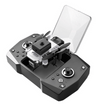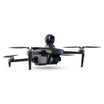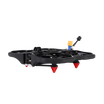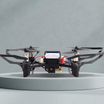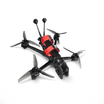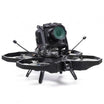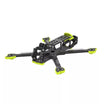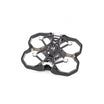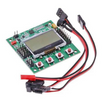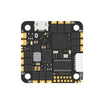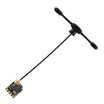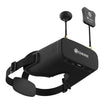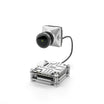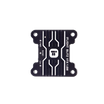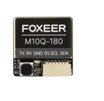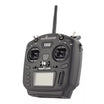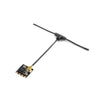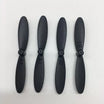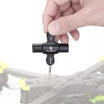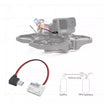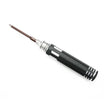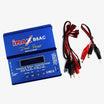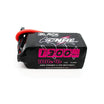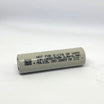So, you want to build or buy an FPV drone, but you keep hearing about “frames”?
It’s a term that might sound simple, but choosing the right FPV frame is one of the most important decisions you’ll make as a drone pilot.
Regardless of whether you're planning to fly freestyle, race competitively, or shoot cinematic videos, this will be an essential choice for you.
In this guide, we’ll explain what FPV drone frames are, why they matter, the different types you’ll come across, and how to choose the perfect one for your needs.
Let’s begin.
What is an FPV Drone Frame?
At its core, the FPV (First Person View) drone frame is like the skeleton of your drone. It’s the rigid structure that holds all essential components together, motors, propellers, battery, flight controller, camera, and even the GPS.
But the frame isn’t just a container, it directly influences your drone’s flight performance, durability, and repairability.
The right frame will not only help your drone fly smoother but also make it easier to fix after a crash (and yes, crashes will happen).
You can always explore our range of quad frames today!
Why is the Frame So Important in FPV Drones?
Especially in FPV drones, where you're flying through tight gaps and often crashing while practicing tricks or racing, the frame quality and design become critically important.
Here’s why choosing the right frame matters:
-
Durability: High-speed crashes are common. A solid frame keeps your expensive components safe.
-
Performance: Frame geometry affects aerodynamics, weight distribution, and flight responsiveness.
-
Repairability: Modular frames with replaceable arms save you money and downtime.
- Camera View: Certain frame styles are designed to keep propellers out of the camera shot, ideal for videography.
Also read: How drones are giving the gift of sight to India
Types of FPV Drone Frames: Explained for Beginners
When choosing your first FPV drone frame, you’ll run into different layouts. Here are the most popular ones explained simply:
#1 X-Frame

Best for: Freestyle flying
Look for if: You want balanced agility and precise control
-
Equal arm lengths form a perfect X.
-
Favored by freestyle pilots for its symmetry and balanced flight.
-
Offers great yaw, pitch, and roll control.
Pro tip: This frame is great for pulling off flips and rolls in open fields or parks.
#2 H-Frame

Best for: Beginners and long-range builds
Look for if: You need extra space for batteries and electronics
-
Shaped like the letter H.
-
Offers a larger internal area, making it beginner-friendly.
-
More stable and forgiving than aggressive X or racing frames.
Tip: Think of the H-frame as the “SUV” of drone frames. It is roomy, strong, and comfortable to learn with.
#3 Stretch X Frame

Best for: Competitive drone racing
Look for if: You want maximum forward stability at high speeds
-
Longer front and rear arms stretch the X-shape.
-
Reduces prop wash (the effect of air from one propeller hitting another).
-
Improves forward tracking and high-speed cornering.
Tip: Not recommended for beginners due to tight builds and advanced flight dynamics.
#4 Deadcat Frame

Best for: Cinematic flying with a clean camera view
Look for if: You don’t want propellers in your video footage
-
Uneven motor positioning pushes front arms outwards.
-
Keeps props out of your GoPro or FPV camera’s field of view.
-
Heavier and less agile, but smoother in the air.
Tip: Ideal for content creators and drone videographers shooting clean footage.
How to Choose Frame Size: 3-inch vs 5-inch vs 7-inch
Frame size refers to the diagonal motor-to-motor distance, not the propeller size, but they’re usually matched.
-
3-inch: Small, nimble, and ideal for indoors or tight spaces.
-
5-inch: Most popular FPV size. Great for freestyle, racing, and general flying.
-
7-inch: Large long-range builds, capable of carrying GPS and extra batteries.
If you're a beginner, a 5-inch frame is a great starting point. It’s widely supported and offers the perfect blend of size, power, and part availability.
Also read: Comparing 7 inch vs 10 inch vs 15 inch Kamikaze drones
FPV Frame Materials: What’s Your Drone Made Of?
The material of your frame plays a big role in durability, weight, and even price.
Carbon Fiber (Most Common)
-
Pros: Lightweight, extremely strong, good vibration dampening.
-
Cons: Can snap under high impact crashes.
-
Best for: Freestyle and racing drones.
Plastic (For Micro Drones)
-
Pros: Flexible, cheaper, safer for indoor use.
-
Cons: Not suitable for high-speed outdoor drones.
-
Best for: Tiny Whoops, beginner indoor builds.
Aluminum/Hybrid Frames
-
Pros: Super strong, modular, good heat dissipation.
-
Cons: Heavier and more expensive.
-
Best for: Cinematic or commercial drone builds.
5 Things to Look For in a Beginner-Friendly Frame
Make sure that you remember:
-
Replaceable Arms: A crash doesn’t have to mean buying a whole new frame.
-
Good Community Support: Pick a frame with lots of build guides and videos.
-
Compatibility with Standard Parts: Make sure it fits 5-inch props, 20x20 or 30x30 stacks, etc.
-
Frame Weight: Lighter = more agile, but more fragile. Heavier = tanky but sluggish.
-
Accessible Layout: Easy to mount and wire components
insideFPV Tip:
If you're just getting started, go for a 5-inch X-frame or H-frame made of carbon fiber, ideally with replaceable arms. It strikes the best balance between learning, crashing, and upgrading later.
By understanding frame types, sizes, and materials, you’ll save time, money, and frustration. More importantly, you’ll build a drone that feels right in the air and that’s what FPV is all about.
Frequently Asked Questions
What is the best FPV frame for beginners?
A 5-inch X-frame or H-frame made of carbon fiber is the best choice for beginners. It offers stability, ease of setup, and community support.
Can I upgrade my drone frame later?
Yes! Frames are modular. As you gain experience, you can upgrade to a frame that better suits racing, long-range, or cinematic needs.
How does frame size affect FPV drone performance?
Smaller frames (3-inch) are nimble and light but have limited range. Larger frames (7-inch) are stable, long-range capable, but need powerful motors and batteries.

